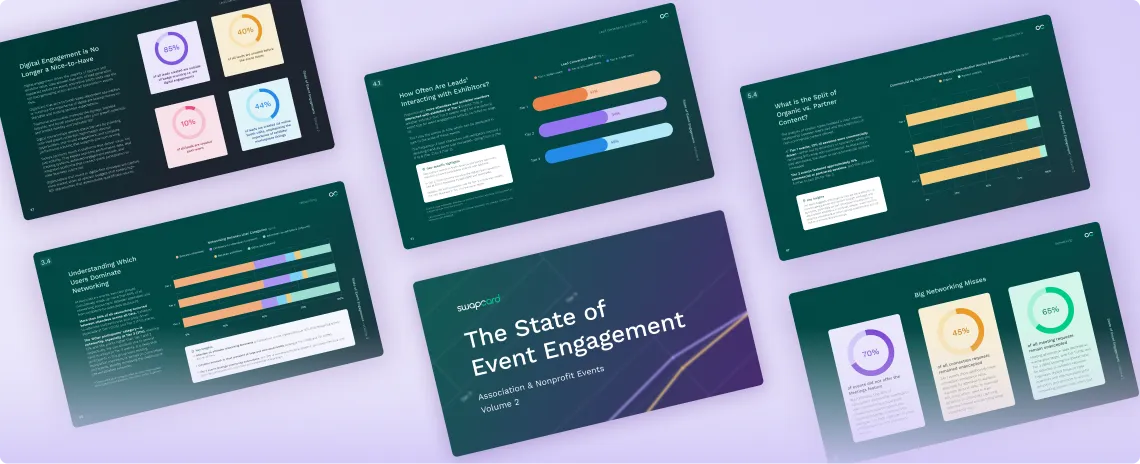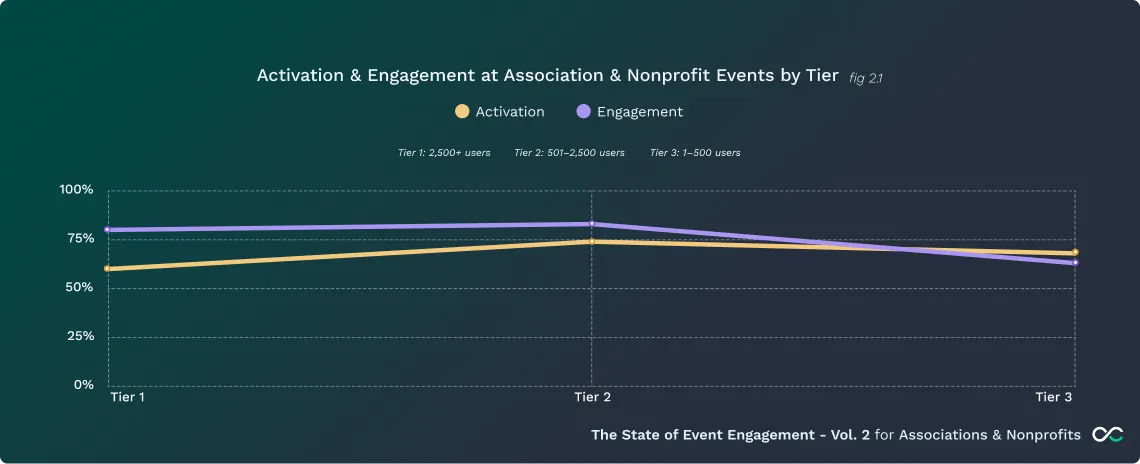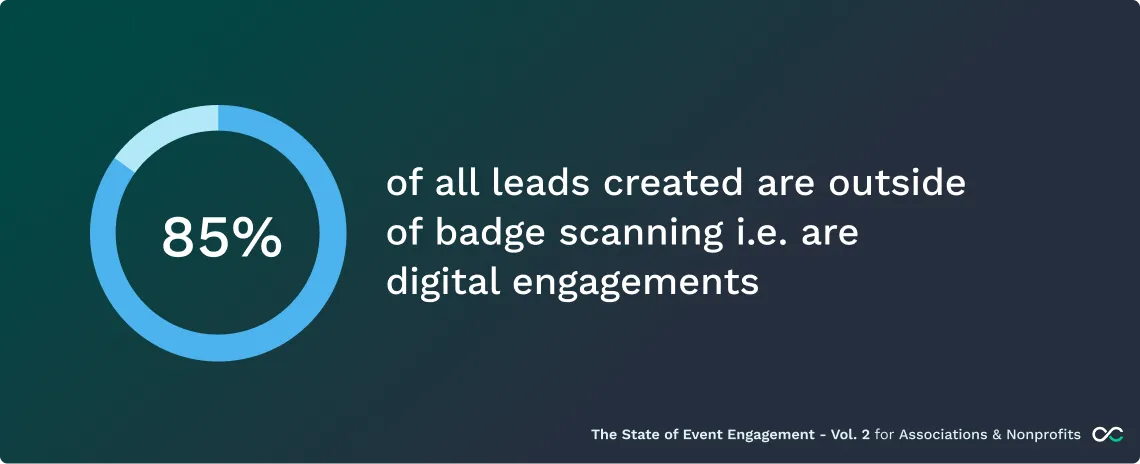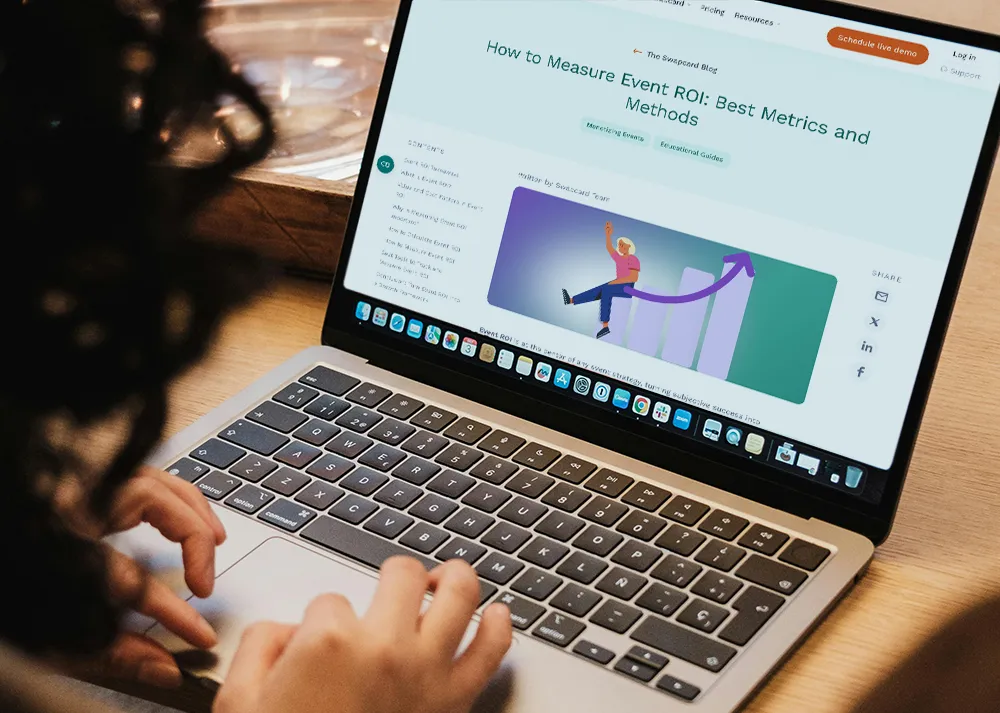What Top-Performing Association Events Do Differently: 2025 Research Insights

In Swapcard’s latest State of Event Engagement Report, we analyzed user behavior across more than 500 Association and Nonprofit events and 500,000+ participants to identify data-backed benchmarks that define high-impact events.
Identifying Top-Performing Events: Methodology and Benchmarks
The phrase “top-performing events” is common, but its meaning can be vague without clear criteria. Our analysis defines it through concrete benchmarks drawn from platform data, combining both user engagement indicators and business outcomes to surface actionable event tech insights that help event organizers, marketers, and program strategists drive measurable impact.
When identifying top-performing events, we looked for those that consistently met or exceeded the following benchmarks:
- Activation rate ≥ 70–74%
- Engagement rate ≥ 80%
- High utilization of AI-powered networking
- 40%+ of exhibitor leads generated pre-event
All findings are based on data from the Swapcard platform, tracking every digital interaction from session engagement and networking requests to exhibitor booth activity.
5 Key Drivers of Success in Leading Association Events
Let’s explore the five strategies that consistently powered high-performing association and nonprofit events—backed by platform data and ready for you to implement.
1. Early Activation Drives Higher Engagement
Our data revealed a strong positive relationship between event activation and engagement—higher activation levels consistently translate into higher engagement.
This trend becomes even clearer when looking at event size (tier) and location (geography). Tier 2 events—mid-sized events with 501 to 2,500 users—showed the highest engagement rates, especially for networking, at 75%. This tier outperformed both Tier 1 events (55%) and Tier 3 events (65%).
A key reason for this appears to be early platform activation. Tier 2 organizers consistently launched their event platforms earlier than those in Tier 1 or Tier 3, giving participants more time to engage before the event began. Our correlation analysis confirmed a strong positive link between early platform activation and higher engagement levels.

Top-performing events launched their platforms at least three weeks before going live. This early activation was paired with phased onboarding tailored for mobile and desktop users, supported by Swapcard’s automated checklists and prompts to ease adoption.
Early access resulted in up to five additional days of pre-event activity, creating more touchpoints for both attendees and sponsors and strengthening overall engagement.
👉 Action point: Open your event platform early and build a multi-phase onboarding strategy to drive initial participation and build momentum.
2. AI-Powered Networking Boosts Connection Rates
Swapcard facilitates meaningful connections with AI-powered contact, exhibitor, and content recommendations.
Association and nonprofit events that leveraged Swapcard’s AI-powered networking saw connection acceptance rates increase by 45%, with Tier 1 association and nonprofit events seeing nearly double the connection acceptance rate.

This led to more relevant peer matches and higher-quality traffic to exhibitor booths—all of which contributed to more meaningful engagement across the event lifecycle.
👉 Action point: Make AI-powered matchmaking a core part of your networking strategy and educate attendees and exhibitors on how to use it to make more relevant and meaningful connections.
3. Early Engagement Leads to Better Exhibitor ROI
At high-performing events, 40% of exhibitor leads were generated before the event opened. This was made possible through proactive content sharing, personalized messaging, and pre-event calls to action.
Swapcard’s exhibitor engagement tools - including customizable digital booths and lead-scoring dashboards - enabled this shift from reactive to strategic exhibitor lead generation.
Exhibitors who embraced this saw not just more leads, but better-qualified ones, leading to stronger post-event conversions.
👉 Action point: Equip your exhibitors with the tools and strategy to engage early—encourage them to share targeted content, send personalized outreach, and use lead-scoring dashboards to identify and prioritize high-potential contacts before the event even begins.
4. Digital Leads Deliver Trackable, Actionable ROI
At top-performing association and nonprofit events, 85% of exhibitor leads were generated through digital interactions rather than badge scans. Exhibitors leveraged in-app engagement, content views, and virtual booth activity—captured on Swapcard’s platform—to collect real-time, actionable data that directly informed their post-event outreach.
Additionally, digital leads come with rich behavioral data—what content was viewed, which sessions were attended, and how long attendees engaged—making segmentation and personalized follow-up significantly more effective.
👉 Action point: Prioritize a digital-first sponsorship strategy. Enable exhibitors to track lead activity through platform analytics, and replace passive touchpoints with meaningful, measurable interactions that align with sponsor expectations for association and nonprofit event ROI and business impact.

5. Session Engagement as a Revenue Driver
At association and nonprofit events, up to 25% of digital leads were generated through session engagement—proving that educational content is not just valuable for learning, but also for conversion.
Top-performing events treated sessions as dual-purpose assets: delivering value to attendees while driving ROI for sponsors. By embedding CTAs like “Book a Meeting” directly within session players, organizers captured audience interest at peak engagement moments—turning passive viewership into measurable outcomes.
Sponsors benefited from increased visibility and timely audience actions, while organizers gathered data to demonstrate the commercial impact of their content strategy.
👉 Action point: Treat sessions as lead-generation channels. Use engagement data to strengthen sponsorship proposals, place CTAs where attention is highest, and position content as a key revenue engine—not just a programming block.
This blog post just scratches the surface of the data and practical takeaways available in the full State of Event Engagement Report: Association & Nonprofit Events, Volume 2.
Download the full report to access:
- Comprehensive event engagement benchmarks by tier and region
- Strategic plays from top-performing organizers
- Best practices for AI-powered networking and attendee onboarding
Join 12,000 subscribers and unlock industry secrets.
By submitting this form, you agree to receive periodic emails on insightful content related to events and our product, and in accordance with our Privacy Policy. You can, of course, change your preferences or unsubscribe at any time.







.svg)


.svg)
.svg)
.svg)





